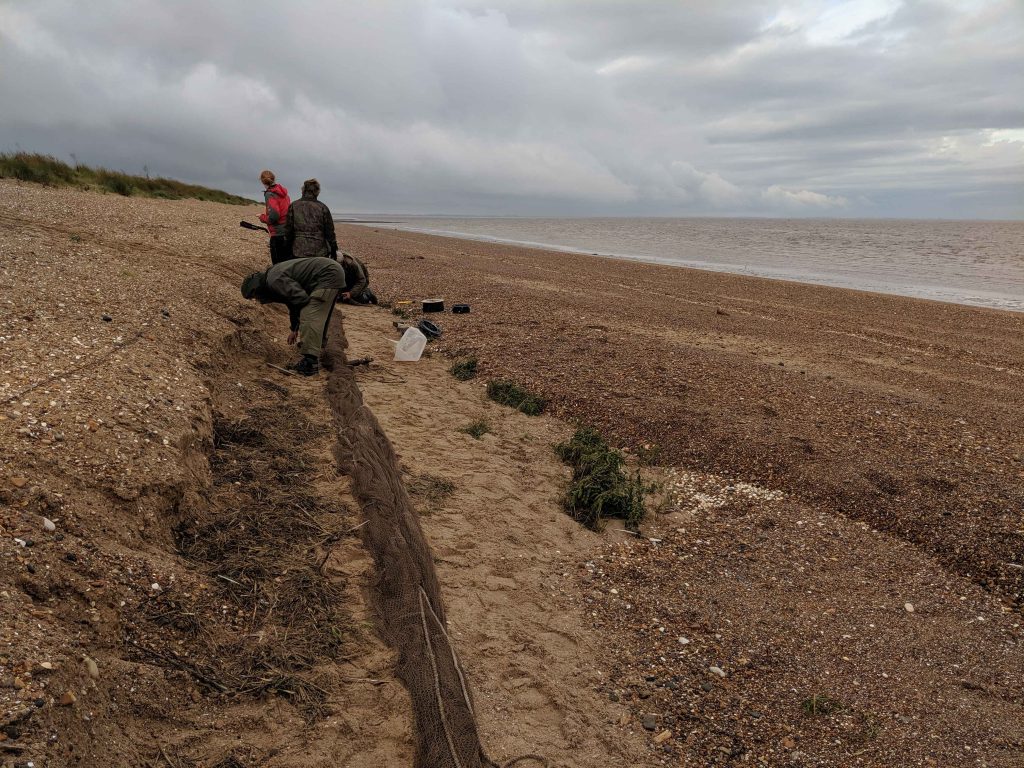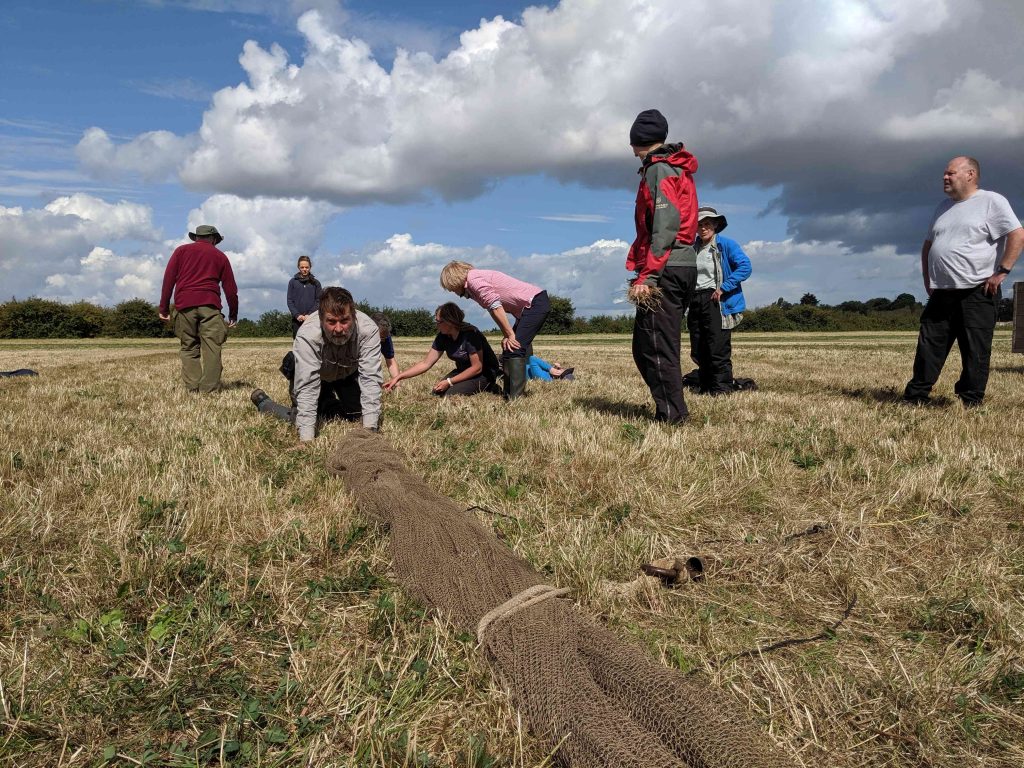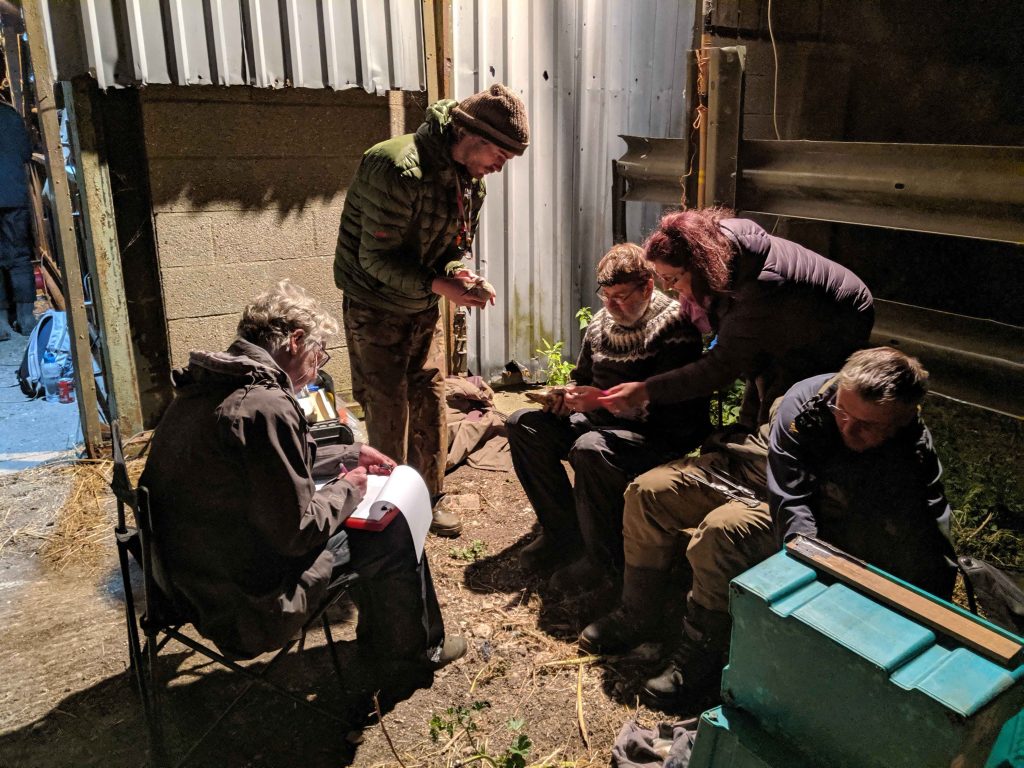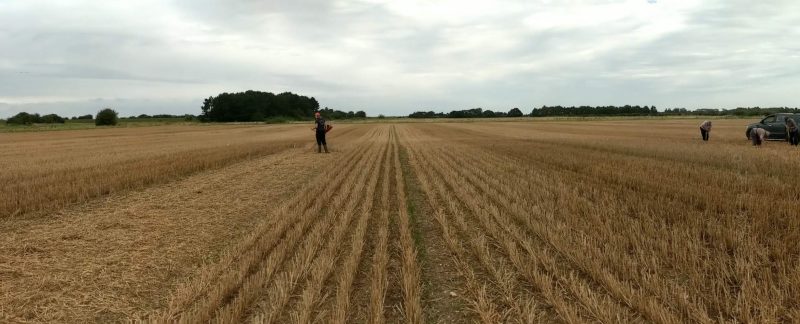Friday 30 August
Nigel recced and found no birds on the Terrington side, so most of the team gathered in Lincolnshire where Steve had identified potential catches of Redshank and Curlew.
Saturday 31 August
Recces: Up 05:30. Lys and Ron went to Gedney, Holbeach and Boat Mere. A field with a flock of 400 Golden Plover and 350 Ringed Plover was the highlight. The Ringed Plovers had arranged themselves in the short lines in the furrows on the field, presumably in order to get out of the wind.
Mark and Jen at Snettisham saw 100 Curlew and a flock of Sanderling at Heacham NN. Phil at Terrington had lots of gulls on the tide edge. The pools were dry.
Nigel had spectacular views and footage of the Red Knot flock at Snettisham Pits and a field on the Royal Estate with 300 Curlew, 800 Bar-tailed Godwit and 150 Black-tailed Godwit. He saw approx. 50 Curlew, godwit and Knot on the shore on the way to the Pits.
The plan was to set nets on the Royal Estate for Sunday morning and to go for a catch of Sanderling at Heachm NN on Saturday evening. The Lincolnshire team came round to Norfolk to help. They set a clap-net pair on one field and the Norfolk team set two clap-net pairs on another. We then went to Snettisham and set two narrow (as firing into water), large-mesh nets on the beach. Supper was eaten behind the beach and then as the hide party got into position they realised that the tide was making and there were 200 Sanderling at 200 yards. Base camp quickly also got into position. Ron and Steve started twinkling however the Sanderling knew where the net was and leapfrogged over it.

Approximately 60 birds went into the catching area and, given the narrow window of opportunity to make a catch on the rising tide, we fired. The rising tide, and the need to lift up the beach resulted in a rolled net. This made extraction of the birds difficult.
Heacham catch totals
| Species | New | Retrap | Total |
| Sanderling | 54 | 17 | 71 |
Quote of the Day: ‘I think the chickens would beat the lawnmower’. This was reference to the two different ways in to the Royal Estate.
Sunday 1 September
Up: hides 04:45; basecamp: 05:15
Recces: Ron went to Holbeach and Lawyer’s Farm and found no birds on the fields. He had hoped to take a look at the marsh, however in the usual car park he was greeted by a lot of young people with old cars, having a ‘rave’! As the volume of the music increased he decided it was time to head for home. On the Lincs side Tom and Gary found 300 Curlew in a brassica field. On return to Tom’s car they found that very unfortunately the tide had reached it.
The catching team went to our two fields on the Royal Estate. When Graham dropped off the hide party on the Lincolnshire set there were 170 Curlew on the field. With the hide in position on the Norfolk team’s set (Nigel’s field, also named the clover field), there were 40 Black-tailed Godwit and 20 Curlew in the area within two minutes. Then 2−300 Curlew and high hundreds of Bar-tailed Godwit arrived. Most of the birds landed with the few decoys in the longer grass. Far fewer landed in the strimmed area. A Muntjac was seen at the field edge. Base camp could see birds flying over our cars and dropping into the net location. After some jiggling we fired the two nets forming the clap net pair covering the unstrimmed part of the catching area.
Clover field catch totals
| Species | New | Retrap | Total |
| Bar-tailed Godwit | 324 | 73 | 397 |
| Black-tailed Godwit | 17 | 0 | 17 |
| Knot | 16 | 0 | 16 |
| Curlew | 20 | 5 | 25 |
| Total | 377 | 78 | 455 |
The covering, extraction and processing went very well and we were able to add some individually marked flags to the Curlew and some colour ring combinations to the Black-tailed Godwit.
On the other field, 20 Curlew had come in early on the decoys but a Pheasant put them up. These birds had headed for Nigel’s field! Later Curlew started arriving again and up to 170 were in the catching area. The hide remarked that Nigel had better have made the right call by suggesting the team manning these nets come and help with the catch already made rather than make a further catch!
After the catch and processing we then reset our fired nets ready for the morning and then returned to base for breakfast. In the afternoon we data checked, cleaned and re-loaded cartridges, a group went out to resight and Nigel did a recce on the saltmarsh. The resighting session was very successful with over 100 birds seen including Knot and Bar-tailed godwit. We had an early night before a cannon-netting morning and an evening mist netting.

Monday 2 September
Up: hide: 05:15; base camp: 05:45. On the ‘clover’ field as the first Curlew landed in the catching area, another was heard calling overhead. Base camp saw two Muntjac. There was a short spell of very light rain and then sunshine and the first Swallow were hunting for insects over the field. We watched the Curlew foraging in the catching area and finding prey (despite the solid nature of the soil, as we found the previous day when digging the cannon holes). A juvenile Bar-tailed Godwit was seen in the catching area and then approximately 25 Black-tailed arrived. At this point someone noticed that there was a car in the field behind the hides. Once the driver had established that we were not some random photographers and were the WWRG he was happy to leave us to it. Thirty or so birds continued to feed or roost in the catching area and a good proportion of the Blackwits were juvenile. Two cars went out to look at neighbouring fields for more birds. As none were found, we fired.
Clover field catch totals
| Species | New | Retrap | Total |
| Curlew | 3 | 0 | 3 |
| Black-tailed Godwit | 22 | 1 | 23 |
| Bar-tailed Godwit | 1 | 0 | 1 |
| Total | 26 | 1 | 27 |
Meanwhile Steve had also made a catch on the other field. Curlew had landed in the field. Wayne twinkled from the saltmarsh and Patricia on the fields.
Steve’s field catch totals
| Species | New | Retrap | Total |
| Curlew | 9 | 2** | 11 |
** One of the retraps had a Finnish ring.
We returned to the Norfolk base for breakfast. A trapped Tree Bumblebee was released from the bathroom. Graham had been recceing in Lincolnshire and had found some waders in a cabbage field but they were not catchable. After breakfast the Lincolnshire team returned to that side of the Wash and we prepared for an evening of mist netting on Terrington Marsh. We put up two sets of nets: the cannon netting pool and the E pool.

Mist netting catch totals
| Species | New | Retrap | Total |
| Knot | 3 | 0 | 3 |
| Grey Plover | 1 | 0 | 1 |
| Turnstone | 6 | 0 | 6 |
| Whimbrel | 1 | 0 | 1 |
| Dunlin | 8 | 0 | 8 |
| Redshank | 65 | 0 | 65 |
| Bar-tailed godwit | 2 | 0 | 2 |
| Total | 86 | 0 | 86 |
While processing we spotted several moth species, including Brimstone, Setaceous Hebrew Character, Angle Shades and Silver Y.
Bed by 01:30
Tuesday 3 September
Most of the team went off to join the Lincs team to cannon net on Horseshoe Lagoon.
Ron and Lucy did a recce at Terrington and found a Woodlark on the sea wall! A first for Lucy at the Wash! Maybe it is a first for the WWRG at the Wash?! As Lucy says it is likely to be a migrant passing through. They also saw 15 Redshank on the cannon-netting pool up to an hour before high water, when they were flushed by a Marsh Harrier. Some of the 500+ Curlew on the marsh started gathering near the two posts slightly to the west of the White Barn. When they left, as this covered, about 200 Curlew stopped for 15 minutes or so on the SW corner of cannon-netting pool. They left as the tide reached the pool and were not seen going inland. There was a lot of raptor activity – at least two Marsh Harrier and a Buzzard.
Nigel and Lys did a recc at Snettisham/Heacham and found 1,000 Sanderling, some Ringed Plover, a few Knot, Turnstone and Oystercatcher on Heacham South. They were well up the beach above a small cliff in the sandy substrate.
In the afternoon we set 11 mist nets in one formation line on the cannon net pool on the saltmarsh. Supper was a lovely lasagne, devised and cooked by Lizzie. The wind meant that the catch was restricted.
Mist netting catch totals
| Species | New | Retrap | Total |
| Grey Plover | 2 | 0 | 2 |
| Dunlin | 4 | 0 | 4 |
| Redshank | 43 | 0 | 43 |
| Turnstone | 1 | 0 | 1 |
| Total | 50 | 0 | 50 |
Wednesday 4 September
Up to set 06:15; rest 06:45
We set three nets almost at the base of the sandy cliff, just allowing the cannons to be put under the net. There was some light rain followed by sunshine. 80 Sanderling, 15 Ringed Plover, 2 Oystercatcher and a few Knot and Turnstone arrived on the beach at nine yards, so not all were catchable. There were other birds around so we waited. Paddy covered a lot of ground twinkling birds which moved towards the net set but then all went past. Tom spotted quite a few Harbour Porpoise but Nigel pointed out that they were ‘not catchable’. Heavy rain ensued and we all went back for breakfast. The evening’s forecast was for more wind making mist netting impossible. So we tidied and cleaned and many people departed that day.
Thursday 5 September
Lou and Gary left base at 07:30 to do some resighting, their total for the trip was:
| Curlew | 83 |
| Bar-tailed Godwit | 36 |
| Knot | 1 |
| Turnstone | 5 |
| Total | 125 |
Cathy, Lizzie and Ryan resighted on the falling tide. Cathy said it was really cold and windy but she read 15 Curlew flags at Snettisham. Ryan and Lizzie: 14 Curlew, 1 Bar-tailed godwit, 2 Redshank. This was a super result and Rob P has produced some summary figures for resightings from July this year.
| Species | Resightings | No. of individuals |
| Curlew | 172 | 82 |
| Bar-tailed Godwit | 51 | 45 |
| Turnstone | 7 | 7 |

